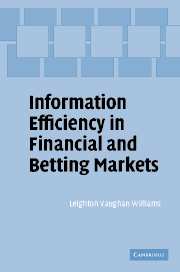Book contents
- Frontmatter
- Contents
- List of figures
- List of tables
- List of contributors
- Introduction
- Part I The concept of information efficiency
- Part II Selected readings
- 4 An assessment of quasi-arbitrage opportunities in two fixed-odds horse-race betting markets
- 5 The presence of favourites and biases in bookmakers' odds
- 6 Searching for semi-strong form inefficiency in the UK racetrack betting market
- 7 Models, markets, polls and pundits: a case study of information efficiency
- 8 Longshot bias: insights from the betting market on men's professional tennis
- 9 Biases and insider trading in exotic bets on thoroughbreds
- 10 On the improbability of information efficient parimutuel betting markets in the presence of heterogeneous beliefs
- 11 Modelling gambling demand in a laboratory casino: discovering the importance of individual-specific effects
- 12 Market efficiency of the 50–30–20–10 horse-racing spread betting market
- 13 Insider trading and bias in a market for state-contingent claims
- 14 Rationality and efficiency in lotto games
- 15 Efficiency of the odds on English professional football matches
- 16 Modelling distance preference in flat racing via average velocity
- 17 Testing for market efficiency in gambling markets: some observations and new statistical tests based on a bootstrap method
- 18 Information (in)efficiency in prediction markets
- Index
- References
18 - Information (in)efficiency in prediction markets
Published online by Cambridge University Press: 09 July 2009
- Frontmatter
- Contents
- List of figures
- List of tables
- List of contributors
- Introduction
- Part I The concept of information efficiency
- Part II Selected readings
- 4 An assessment of quasi-arbitrage opportunities in two fixed-odds horse-race betting markets
- 5 The presence of favourites and biases in bookmakers' odds
- 6 Searching for semi-strong form inefficiency in the UK racetrack betting market
- 7 Models, markets, polls and pundits: a case study of information efficiency
- 8 Longshot bias: insights from the betting market on men's professional tennis
- 9 Biases and insider trading in exotic bets on thoroughbreds
- 10 On the improbability of information efficient parimutuel betting markets in the presence of heterogeneous beliefs
- 11 Modelling gambling demand in a laboratory casino: discovering the importance of individual-specific effects
- 12 Market efficiency of the 50–30–20–10 horse-racing spread betting market
- 13 Insider trading and bias in a market for state-contingent claims
- 14 Rationality and efficiency in lotto games
- 15 Efficiency of the odds on English professional football matches
- 16 Modelling distance preference in flat racing via average velocity
- 17 Testing for market efficiency in gambling markets: some observations and new statistical tests based on a bootstrap method
- 18 Information (in)efficiency in prediction markets
- Index
- References
Summary
Introduction
This chapter examines a new class of markets at the intersection of traditional betting and traditional financial markets. We call these ‘prediction markets’. Like both financial and betting markets, prediction markets focus on uncertain outcomes and involve trading in risks. Prices from these markets establish forecasts about the probabilities, mean and median outcomes, and correlations among future events. These prices have been used to accurately predict vote shares in elections, the box office success of Hollywood movies and the probability that Saddam Hussein would be deposed by a certain date. Other names for these markets include ‘virtual stock markets’, ‘event futures’, and ‘information markets’.
Financial economists have long known about the information-aggregating properties of markets. Indeed, the efficient markets hypothesis, a centrepiece of financial theory, can be stated simply as, ‘market prices incorporate all available information’. While financial instruments can be very complex, prediction markets tend to be analytically simple. Their current simplicity, however, belies their powerful potential future as a way to hedge against geopolitical and other forms of risk as envisioned by Athanasoulis, Shiller and van Wincoop (1999) and Shiller (2003).
Currently, most prediction markets are quite small, with turnover ranging from a few thousand dollars on the early political markets run by the University of Iowa, to several million bet in the 2004 election cycle on TradeSports, to hundreds of millions bet on the announcement of economic indicators in Goldman Sachs and Deutsche Bank's ‘Economic Derivatives’ market.
- Type
- Chapter
- Information
- Information Efficiency in Financial and Betting Markets , pp. 366 - 386Publisher: Cambridge University PressPrint publication year: 2005
References
- 13
- Cited by

